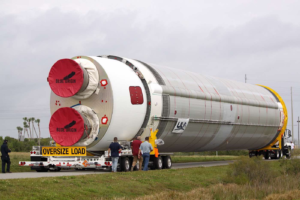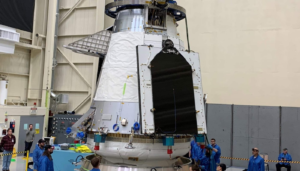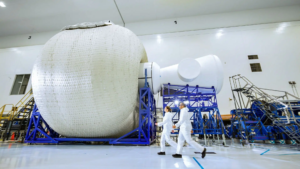
Dream Chaser Tenacity Is Getting Ready To Launch!
Right now, Sierra Space and NASA are completing the final testing of Dream Chaser Tenacity, the first spaceplane test article getting ready to launch in the coming months. At the same time, they are also preparing other aspects including the launch plan, International Space Station, crews, etc.
Just recently, NASA released a nearly full flight profile of Tenacity’s first mission. This gives insight into the maiden flight, ISS approach, berthing, its stay at the station, and the return to Earth. All of which will be the firsts for this vehicle and the first spaceplane to do it in decades. Here I will go more in-depth into Tenacity’s maiden flight, some of the mission’s primary milestones, current progress, and more.
Tenacity’s First Launch

By now, Dream Chaser is still scheduled to launch on United Launch Alliance’s Vulcan Centaur. A few weeks ago the rocket completed a successful maiden flight which was an important step to ensure the next mission with Tenacity stays somewhat on schedule. While there isn’t an official launch date yet, we do have a good idea of when to expect it. A few months ago Janet Kavandi, Sierra Space’s president and chief science officer stated that the mission is set to happen in April 2024. With this in mind, assuming Tenacity’s final testing finishes as expected in likely the next few weeks, the mission will be set to happen very soon.
Looking at the mission plan, it’s going to be a jam-packed maiden flight. Once Tenacity and Vulcan are both at the launch site, they will be integrated together. With this being an uncrewed Dream Chaser, it will sit within Vulcan’s fairings as it doesn’t require an abort capability. In a statement, NASA said “During its first flight, Sierra Space will conduct in-orbit demonstrations to certify Dream Chaser for future missions. Teams at NASA’s Kennedy Space Center in Florida, NASA’s Johnson Space Center in Houston, and the Dream Chaser Mission Control Center in Louisville, Colorado, will monitor the flight. Sierra Space flight controllers will control the Dream Chaser spacecraft on the launch pad until the spacecraft is handed over to the Sierra Space ground operations team at NASA Kennedy following landing.”
After it’s launched and separated from Vulcan’s upper stage, the real mission begins. They mentioned that far-field demonstrations will be conducted outside the vicinity of the space station before the spacecraft enters the approach ellipsoid, a 2.5-by-1.25-by-1.25-mile (4-by-2-by-2-kilometer) invisible boundary around the orbiting laboratory. These demonstrations will be required before Dream Chaser can enter joint operations with the NASA team at the Mission Control Center in Houston. These include demonstrating attitude control, translational maneuvers, and abort capabilities.” In other words, NASA needs to make sure Tenacity is fully capable and in control before it gets anywhere near the ISS.
Next, “Near-field demonstrations, which must happen closer to the space station, include activating and using light detection and ranging (LIDAR) sensors, responding to commands sent from the space station, retreating from the station when commanded, and holding its approach, first at 1,083 feet (330 meters), then 820 feet (250 meters), and finally, at 98 feet (30 meters) from the station. Following the successful completion of the demonstrations, Dream Chaser will move towards the space station.”
Here, as Dream Chaser approaches the orbiting laboratory, it will hold a final time approximately 38 feet (11.5 meters) from the space station, when a station crew member will use Canadarm2 robotic arm to grapple a fixture on the spacecraft’s cargo module before teams on the ground install the cargo module to an Earth-facing port on the Unity or Harmony module. Specifically, it will grab onto Shooting Star, which is attached to the back of Tenacity. On this first flight to the International Space Station, Dream Chaser is scheduled to deliver over 7,800 pounds (3,500 kg) of cargo. On future missions, Dream Chaser is being designed to stay attached to the station for up to 75 days and deliver as much as 11,500 pounds (5,200 kg) of cargo. This cargo can be loaded onto the spacecraft as late as 24 hours prior to launch. When coming back to Earth, Dream Chaser can return over 3,500 pounds (1,600 kg) of cargo and experiment samples to Earth, while over 8,700 pounds (3,950 kg) of trash can be disposed of during reentry using its cargo module.
At the time of arrival, the ISS is expected to have a number of different astronauts on board. Some of them have already been to Sierra Space’s facilities to train and fully understand the vehicle for when the time comes.
Tenacity’s Trip Home

The first part of the mission consists of approaching and berthing to the ISS, a significant milestone. However, the second part is easily the most complex, as Tenacity will attempt to reenter the Earth’s atmosphere for the first time ever.
In total, Dream Chaser will remain at the space station for about 45 days before it is uninstalled using Canadarm2. NASA points out that “The spacecraft can land as quickly as 11 to 15 hours after departure, and there are daily opportunities if weather criteria are met. Landing weather criteria for Dream Chaser generally require crosswinds at less than 17.2 miles per hour (15 knots), headwinds under 23 mph (20 knots), and tailwinds below 11.5 mph (10 knots). Thunderstorms, lightning, and rain within a 20-mile radius of the runway or 10 miles along the approach path are not acceptable conditions for landing. Detailed flight rules will guide controllers in determining whether landing opportunities are favorable.
Once Dream Chaser has moved away from the station and disconnected from the Shooting Star module, a combination of Dream Chaser’s 26 reaction control system thrusters will fire to commit the spacecraft to deorbit. Dream Chaser will re-enter Earth’s atmosphere and be exposed to the immensely powerful heat. In the decades that Dream Chaser has been in development, a major focus has been on altering and improving its heat shield. In total, Dream Chaser uses approximately 2,000 Thermal Protection System (TPS) tiles across its body. These wrap all along the sides of the vehicle, go around to the top, bottom, and even cover various control surfaces on the spaceplane.
On average, Dream Chaser tiles are around 10 inches by 10 inches. This larger size in comparison to the Shuttle and other spacecraft, is a big benefit as it reduces the number of tiles in total and simplifies the installation process. However, while the average tile is quite large, there are plenty of individual spots that require awkward shapes and installs. For example, along the transition between white and black tiles, you can see quite a few small tiles in addition to various shapes. The location of the tiles relative to the spaceplane determines its color, either white or black. In this case, the white tiles reject more heat from the sun while on-orbit, which helps to keep the components within Dream Chaser cooler.
Besides the size and color, the company highlighted that SNC engineers have been able to update the TPS tiles from what was used during NASA’s shuttle program with more innovation, better technology, and utilizing lessons learned. Specifically, they use more modern manufacturing techniques to increase strength and reduce cost. Not to mention, Dream Chaser tiles are stronger and lighter weight than those used during the shuttle program and meet all Micro-Meteroid Orbital Debris (MMOD) requirements to ensure safe entry, descent, and runway landings for crewed or cargo missions.
Assuming these upgrades and changes all work, Tenacity will successfully make it through reentry. At that point, it would glide to a runway landing at Kennedy’s Launch and Landing Facility in the style of NASA’s space shuttle, becoming the first spacecraft to land at the facility since the final space shuttle flight in 2011. NASA was quoted saying, “Once Dream Chaser is powered down after landing, the Sierra Space ground operations team will transfer it to the Space System Processing Facility to perform necessary inspections, off-load remaining NASA cargo, and begin the process of preparing it for the next mission.
This is the exact flight profile and plan expected to take place in only a few months. In December, Dream Chaser and Shooting Star, arrived at NASA’s Neil Armstrong Test Facility in Ohio, for environmental testing. There, the Dream Chaser winged spacecraft was set to be stacked atop its Shooting Star cargo module on the vibration table to experience vibrations like those during launch and re-entry to the Earth’s atmosphere. Following vibration testing, Dream Chaser was planned to be moved to the propulsion facility for thermal vacuum testing. Here it would be placed in a vacuum and exposed to low ambient pressures, low-background temperatures, and replicated dynamic solar heating, which simulates the environment the spacecraft will encounter during its mission. While we haven’t received any updates since then, Tenacity is likely completing this process now or has just finished it. Either way, in the next few weeks we can expect to hear more about the Spaceplane and its upcoming mission.
Conclusion
Dream Chaser Tenacity is only a few months away from its first test flight. A new document from NASA highlights the mission profile and slow approach to the ISS before it’s berthed to the station. We will have to wait and see how it progresses and the impact it has on the space industry.



